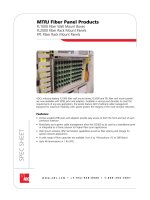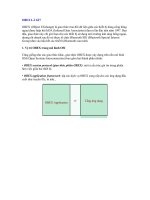Tài liệu Configure CGMP on Switches ppt
Bạn đang xem bản rút gọn của tài liệu. Xem và tải ngay bản đầy đủ của tài liệu tại đây (208.07 KB, 12 trang )
Lab 9.5.4: Configure CGMP on Switches
Accounting
VLAN10
10.1.10.0/24
Marketing
VLAN20
10.1.20.0/24
Engineering
VLAN30
10.1.30.0/24
10.1.10.3
Multicast Client
DLSwitch
4006
10.1.1.11/24
native
VLAN1
10.1.10.0/24
DLRouter
10.1.10.2
Multicast Server
CGMP Enabled
10.1.1.0/24
10.1.30.2
Multicast Client
Objective:
Configure CGMP on switches.
Scenario:
Current Environment
Your network switching equipment currently includes a 4006 switch segmented into four
functional areas for better network management and traffic control. VLANs implemented
throughout your Cisco switched network include “Accounting”, “Marketing” and “Engineering” for
the users and “default” used for the native VLAN for network management. Inter-VLAN routing
has been implemented on the 4006 to allow individuals and servers on your Virtual LANs to
exchange information.
Enhancement
The Accounting department operating on VLAN 10 would like you to implement a Cisco IP/TV
multicast server that will facilitate the distribution of media streams throughout the company’s
network. It is important that clients from any VLAN on the company’s network are able to receive
both continuous streams and video on demand from the multicast server on VLAN 10.
Design:
Switched Network VTP Configuration Information:
Switch VTP Domain VTP Mode
DLSwitch CORP Server
VLAN Configuration Information:
VLAN
ID
VLAN
Name
VLAN
Subnet
VLAN
Gateway
1 default 10.1.1.0/24 10.1.1.1
10 Accounting 10.1.10.0/24 10.1.10.1
20 Marketing 10.1.20.0/24 10.1.20.1
30 Engineering 10.1.30.0/24 10.1.30.1
Switch VLAN Port Assignments:
Switch VLAN 1 VLAN
10
VLAN
20
VLAN
30
Trunk
DLSwitch 3-18 19-24 25-30 31-34 1,2
Cisco 4006 DLRouter Interface Configuration Information:
Interface IP Address VLAN
PortChannel 1.1 10.1.1.1/24 Native 1
PortChannel 1.10 10.1.10.1/24 10
PortChannel 1.20 10.1.20.1/24 20
PortChannel 1.30 10.1.30.1/24 30
Notes:
Lab Tasks:
1. Cable the lab as shown in the diagram. We will expedite the basic switch configurations
to focus on multicast processing within a VLAN environment.
2. The first device to be configured will be the distribution layer switch DLSwitch. Access
the switch through the console port and enter privileged mode. Clear your NVRAM and
reload.
Switch> (enable) clear config all
Switch> (enable) reset
3. Configure the DLSwitch with the following information:
a. Configure the prompt DLSwitch on the 4006 switch.
Switch> (enable) set prompt DLSwitch>
or
Switch> (enable) set system name DLSwitch>
* Note: Verify using DLSwitch> (enable) show config
b. Configure VTP information on the 4006 switch.
DLSwitch> (enable) set vtp domain CORP
DLSwitch> (enable) set vtp mode server
* Note: Verify using DLSwitch> (enable) show vtp domain
c. Create corporate VLAN’s.
DLSwitch> (enable) set vlan 1 name default
DLSwitch> (enable) set vlan 10 name Accounting
DLSwitch> (enable) set vlan 20 name Marketing
DLSwitch> (enable) set vlan 30 name Engineering
* Note: Verify using DLSwitch> (enable) show vlan
d. Set switch IP address information and gateway. Again this is for management and is
not required for switch functionality. It would be assumed that you might want to
Telnet to the switch though.
DLSwitch> (enable) set interface sc0 up
DLSwitch> (enable) set interface sc0 1 10.1.1.11/255.255.255.0
10.1.1.255
DLSwitch> (enable) set ip route 0.0.0.0/0.0.0.0 10.1.1.1
* Note: Verify using DLSwitch> (enable) show config
e. Set port channel admin groups.
DLSwitch> (enable) set port channel 2/1-2 156
* Note: Verify using DLSwitch> (enable) show config
f. Assign port VLAN memberships. If you use the show vlan command you will see
that all VLANs default to VLAN 1.
DLSwitch> (enable) set vlan 1 2/3-34
* Note: The above command simply resets all ports on the switch to VLAN 1 or the
native VLAN. Below we will specify several other assignments of various ports to
different VLANs. Please take note of the assignments with connecting devices.
DLSwitch> (enable) set vlan 10 2/19-24
DLSwitch> (enable) set vlan 20 2/25-30
DLSwitch> (enable) set vlan 30 2/31-34
* Note: Verify using DLSwitch> (enable) show vlan
g. Establish VLAN trunking. These commands allow us to establish trunking
preparation to the L3 Routing Switch module in the 4006 switch itself.
DLSwitch> (enable) set trunk 2/1 nonegotiate dot1q 1-1005
DLSwitch> (enable) set trunk 2/2 nonegotiate dot1q 1-1005
* Note: the show trunk command will not display necessary information because
the trunk links may not yet be active. Ensure the config commands are entered
though.
h. Establish Fast EtherChannel on trunking interfaces.
DLSwitch> (enable) set port channel 2/1-2 mode on
* Note: Verify using DLSwitch> (enable) show channel
i. Enable PortFast on ports 3 through 34. This block of ports will be reserved for end
host device connections until otherwise configured.
DLSwitch> (enable) set spantree portfast 2/3-34 enable
* Note: Verify using DLSwitch> (enable) show channel
j. Establish switch passwords. Always a good idea and required for VTY sessions for
management. We will use “cisco” throughout this lab for all passwords.
DLSwitch> (enable) set enablepass <enter>
* You will be prompted to enter and confirm the password
DLSwitch> (enable) set password <enter>
* You will be prompted to enter and confirm the password
k. Verify complete configuration using DLSwitch> (enable) show config.
4. The next device to be configured will be the distribution layer router DLRouter.
DLSwitch> (enable) session 2
Router#clear start
Router#reload
Note: If asked to save system information select “N”
After the card reset then go back into it:
DLSwitch> (enable) session 2
5. Configure the DLRouter with the following information:
a. Configure the hostname DLRouter on the 4006 L3 module.
Router(config)#hostname DLRouter
* Note: Verify using DLRouter#show run
b. Configure the privileged mode password. Good idea and required for Telnet access.
DLRouter(config)#enable password cisco
* Note: Verify using DLRouter#show run
c. Configure the VLAN interface addressing and trunking information.
DLRouter(config)#interface Port-channel1
DLRouter(config-if)#ip address 10.1.1.1 255.255.255.0
DLRouter(config-if)#no shutdown
DLRouter(config)#interface Port-channel1.10
DLRouter(config-if)#encapsulation dot1Q 10
DLRouter(config-if)#ip address 10.1.10.1 255.255.255.0
DLRouter(config)#interface Port-channel1.20
DLRouter(config-if)#encapsulation dot1Q 20
DLRouter(config-if)#ip address 10.1.20.1 255.255.255.0
DLRouter(config)#interface Port-channel1.30
DLRouter(config-if)#encapsulation dot1Q 30
DLRouter(config-if)#ip address 10.1.30.1 255.255.255.0
* Note: Verify using DLRouter#show run
d. Assign the PortChannel to the Gigabit interfaces channeling to the switch.
DLRouter(config)#interface GigabitEthernet3
DLRouter(config-if)#channel-group 1
DLRouter(config)#interface GigabitEthernet4
DLRouter(config-if)#channel-group 1
* Note: Verify using DLRouter#show run
e. Configure your corporate routing protocol
DLRouter(config)#router eigrp 1
DLRouter(config-router)#network 10.0.0.0
* Note: Verify using DLRouter#show run
f. Configure your telnet virtual terminal password information. Again recommended
and necessary.
DLRouter(config)#line vty 0 4
DLRouter(config-line)#password cisco
DLRouter(config-line)#login
* Note: Verify using DLRouter#show run
g. Verify complete configuration using DLRouter#show run.









